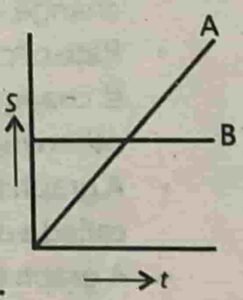MCQs Class 9 Physics New Book Chapter 2
Multiple Choice Questions ( MCQs ) Class 9 Physics Chapter 2 Kinematics 2025
Tick the correct answer.
2.1 The numerical ratio of displacement to distance is:
(a) always less than one (b) always equal to one (c) always greater than one (d) equal to or less than one
Option (d) is correct.
Explanation:-
Because displacement is the shortest distance so, distance will always be equal or greater than the displacement.
If motion is in straight line, ration between displacement and distance will be 1.
But, if displacement is less than distance, that is motion is curved, numerical ratio of displacement to distance will also be less than 1.
————————————————————————————————————————————————–
2.2 If a body does not change its position with respect to some fixed point, then it will be in a state of:
(a) rest (b) motion (c) uniform motion (d) variable motion
Option (a) is correct
Explanation:-
Rest means object is not changing its position with respect to its surroundings
————————————————————————————————————————————————–
2.3 A boll is dropped from the top of a tower, the distance covered by it in the first second is:
(a) 5 m (b) 10 m (C) 50 m (d) 100 m
Option ( a ) is correct.
Explanation:-
$$Initial\;velocity=v_i=\;0\\Acceleration=g=10\;ms^{-2}\\Time\;=\;t\;=\;1\;s\\Dis\tan ce\;=\;S\;=\;?$$
FORMULA:- $$S\;=\;v_it\;+\frac12gt^2$$
$$S\;=(0)\;(1)+\frac12(10)\;{(1)}^2\\\\S\;=\;5\;m$$
————————————————————————————————————————————————–
2.4 A body accelerates from rest to a velocity of 144 Km in 20 second. The distance covered by it is:
(a) 100 m (b) 400 m (c) 1400 m (d) 1440 m
Option ( b ) is correct.
Explanation:-
$$Initial\;velocity=v_i=0\\\\Final\;velocity=v_f=144kmh^{-1}\\=144\;(\frac{1000}{3600})\;=\;40\;ms^{-1}\\\\Time\;=\;t\;=\;20\;s\\Dis\tan ce\;=\;S\;=\;?\\$$
FORMULA:- $$S\;=\;V_{av}\;\times\;t\\\\S\;=\;(\frac{v_i\;+\;v_f}2)\;t\\$$
$$After\;putting\;the\;values\\We\;get\\\\S\;=\;(\frac{0\;+\;40}2)\;(\;20\;)\\S\;=\;400\;m\\$$
————————————————————————————————————————————————–
2.5 A body is moving with constant acceleration starting from rest. It covers a distance S in 4 seconds. How much time does it take to cover one-fourth of this distance?
(a) 1 s (b) 2 s (c) 4 s (d) 16 s
Option ( b ) is correct.
Explanation:-
$$Initial\;velcoity=v_i=\;0\\\\Dis\tan ce\;=\;S\;=\;?\\\\\frac14S\;=\;S_1\;=\;?\\\\Time\;=\;t\;=\;4\;s\\\\Time\;for\;S_1\;=\;t_1\;=\;?$$
Formula:-
$$2nd\;equation\;of\;motion\\S\;=\;V_i\;t\;+\;\frac12\;a\;t^2$$
$$After\;putting\;the\;values\\We\;get\\\\S\;=\;0(4)\;+\;\frac12a{(4)}^2\\S\;=\;8\;a$$
$$Divding\;both\;the\\sides\;by\;4\\\\\frac S4=\;\frac{8\;a}4\\\\S_1\;=\;2\;a$$
Formula:-
Again We will use 2nd equation of motion
$$S_1\;=v_i\;t_1\;+\;\frac12\;a\;t_1^2\\$$
$$After\;putting\;the\;values\\We\;get\\\\2a\;=\;0(t_1)\;+\;\frac12a\;\;t_1^2\\4\;=\;\;t_1^2\\\\taking\;square\;root\\on\;both\;ths\;side\\\\\pm2\;=\;t_1\\\\Time\;starts\;from\;0\\So,\;we\;will\;neglect\\the\;negative\;sign\\\\t_1\;=\;2\;s\\$$
————————————————————————————————————————————————–
2.6 The displacement time graphs of two objects A and B are shown in the figure. Point out the true statement from the following:

(a) The velocity of A is greater than B. (b) The velocity of A is less than B. (c) The velocity of A is equal to that of the B. (d) The graph gives no information in this regard.
Option ( a ) is correct.
Explanation:-
Line of object B is parallel to t-axis, so object B is at rest.
Line of object B shows that its distance is uniformly increasing with respect to time, so its speed is increasing.
————————————————————————————————————————————————–
2.7 The area under the speed-time graph is numerically equal to:
(a) velocity (b) uniform velocity (c) acceleration (d) distance covered
Option ( d ) is correct.
Explanation:-
Because S = V t. Distance is equal to the product of speed and time.
————————————————————————————————————————————————–
2.8 Gradient of the speed-time graph is equal to:
(a) speed (b) velocity (c) acceleration (d) distance covered
Option ( c ) is correct.
Explanation:-
Gradient means slope which is ration between rise and run.
Speed divided by time gives us acceleration.
So, gradient of speed-time graph gives acceleration.
————————————————————————————————————————————————–
2.9 Gradient of distance time graph is equal to
(a) speed (b) velocity (c) distance covered (d) acceleration
Option ( b ) is correct.
Explanation:-
Gradient means slope which is ration between rise and run.
Distance divided by time gives us speed.
So, gradient of distance-time graph gives speed. If distance is displacement, we will get velocity.
————————————————————————————————————————————————–
2.10 $$A\;car\;accelerates\;uniformly\\from\;80.5\;km\;h^{-1}\;at\;t\;=\;0\\to\;113\;km\;h^{-1}\;at\;t\;=\;9s\\Which\;graph\;best\;describes\\the\;motion\;of\;the\;car\;?$$

Option ( c ) is correct.
Explanation:-
After converting the speeds in meters per second, we get 22.36 meters at t=0 and 31.39 m at t=9.
So graph graph will not start from origin, Option b is incorrect.
Its speed is increasing, so option d is also incorrect.
In option a there is no straight line, so its also incorrect.
When we plot the graph of ( 0 , 22.36 ) and ( 9 , 31.39 ), we get option c
———————————————————————————————————-—————————————-
Check! Some useful links below
MCQs Class 9 Physics New Book Chapter 1
9th Physics 2025 chapter 2 numerical
You tube channel for 9th Class New syllabus Sir Najam
Home Page Notespunjab.com




